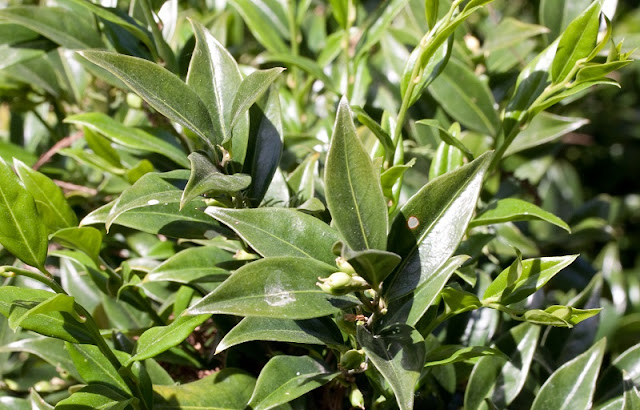 |
| The 'Sweet Box' - Sarcococca confusa |
The 'Sweet Box' - Sarcococca confusa may not be particularly eye-catching, but when you stroll past a specimen in full winters bloom it is undeniably nose-catching, if such a conjoined word exists! The common name is in reference to its similarity to the common box, Buxus sempervirens.
Under favourable conditions you can expect the sweet box to reach a mature height of 2 metres with a width of 1 metre. It is a compact, evergreen shrub with glossy, green, ovate leaves and a spreading habit. The origins of Sarcococca confusa are uncertain but it is generally believed to derive from China. Strangely it is not matched by any wild specimen, but there is some belief that it may have been raised from seeds collected by Ernest Henry 'Chinese' Wilson (1876 – 1930) in Western China. It was subsequently brought under cultivation in England around 1916.
The most notable feature of the sweet box is its highly fragrant, honey-scented blooms. The white flowers with cream-coloured anthers appear over the winter and once pollinated are followed by glossy, black berries 5 mm in diameter. In fact the genus name Sarcococca originates from the Greek meaning 'fleshy berry', referring to the fruit.
The sweet box is relatively easy to grow and will perform well when grow in moderately fertile, moist but well-drained humus-rich soil. It will perform best in shade as the foliage can bleach when exposed to full sun.. Semi-shade and full sun can be tolerated if the soil remains reliably moist during the growing period
It is also tolerant of atmospheric pollution, and once established will also be tolerant of drought and neglect. Like the true box - Buxus sempervirens, it is ideal for creating an informal low hedge.
Sarcococca confusa received the Award of Garden Merit in 1984.
Main image credit - Denis.prévôt
HOW TO GROW THE CHRISTMAS BOX - Sarcococca hookeriana var. humilis







No comments:
Post a Comment